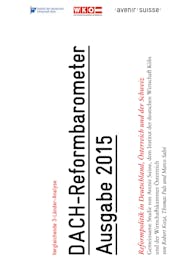Switzerland’s enthusiasm for economic policy reform ebbed further in 2014, according to the latest “D A CH Reform Barometer” from Avenir Suisse, Germany’s Institut der Deutschen Wirtschaft in Cologne and the Wirtschaftskammer Österreich. The study covers efforts to reform in the three countries and focuses on five economic policy fields. The analysis is based on political initiatives at federal level that have a chance of becoming law. Indexed at 100 in September 2002, the subsequent scores illustrate each country’s reform dynamics. By end 2014, Switzerland stood at 115.6 – down 0.6 percentage points on the year, and a lower rating for the second year running. Germany (minus 0.8 points to 111.2) and Austria (minus 0.1 points to 114.7) were also down.
The 2011-15 legislative period in Switzerland has been undistinguished in terms of liberalisation. That is particularly marked compared with the two previous legislatures, which were characterised by greater reforming zeal.
Avenir Suisse’s assessment of the two most important initiatives – the belated adjustments to old age pensions, and reform of corporate taxation – was mixed. Regarding the former, the fact that the central issue of pensionable age was barely addressed was a negative. As to company tax, the judgement was cautiously positive, even if the changes signified an (unavoidable) departure from a system viewed as optimal from the Swiss point of view. It remains to be seen whether this autumn’s federal elections will produce a new, more reform-minded parliament – something urgently needed given the strong Swiss franc.
Developments in social policy contributed most strongly to the decline in Switzerland’s overall reform score. The social policy rating fell by 2.3 points to 98.4 in 2014 – entirely due to the negative assessment of the “Pensions 2020” reform package. While the changes should virtually halve the funding gap in the AHV ((Switzerland’s statutory old age pension scheme, ed)), any reform that excludes a rise in statutory pensionable age must be considered unnecessarily expensive and, ultimately, unsustainable.
The tax and financial policy sub index improved in 2014, with a 0.8 point rise to 133.0. The main contributor here was the latest corporate tax reform, which should decisively reduce current fiscal uncertainties. Although the reform has attempted to minimise an (inevitable) loss of appeal for Switzerland as an investment location, that will not be entirely possible given the current regime is optimal from a Swiss economic point of view ((the changes represent in part a response to accusations of unfair tax competition from Switzerland’s European neighbours, ed))
In 2014, as in the previous year, neither the labour market nor education policy were top priorities on the parliamentary agenda. A significant in this sub index was prevented by the decisive rejection of the referendum on a minimum wage. The sub index closed the year unchanged at 116.5.
Competition and innovation policy, which also includes infrastructure policy, was the busiest field in 2014, with eight measures considered in the annual reform barometer. The overall result was clearly negative, with the index down 1.5 points to 112.9. Most deleterious here were the revisions to environmental protection law put forward by the government as its counter proposal to the “Grüne Wirtschaft” (Green Economy) referendum initiative. Although, here too, business friendly changes were introduced in the Council of States (upper chamber of parliament, ed), the overall legislative impact opened the door to potential new trading barriers and distortions to competition while raising regulatory costs for business.
The Reform Barometer‘s final area covers financial markets policy. Between December 2013 and December 2014, this sub index fell by 1.5 points to 116.9. Switzerland has been under heavy pressure as a financial centre for several years now. After many setbacks and forced concessions, 2014 was a somewhat “quieter” year. Bern’s not entirely voluntary strategy of international co-operation bore first fruits – seen in limited agreements with Italy and France. Nevertheless, the banking sector remains can hardly be said to have returned to “business as usual.” Sources of uncertainty remain, for example in the form of the European Union’s MIFID internal market harmonisation rules. It is to be feared that each further step to integration will be combined with a further twist in the already very tight leash on which financial institutions are held.
The following graphic is available in German only:





